This article was co-authored by Laura Marusinec, MD and by wikiHow staff writer, Luke Smith, MFA. Dr. Marusinec is a board certified Pediatrician at the Children's Hospital of Wisconsin, where she is on the Clinical Practice Council. She received her M.D. from the Medical College of Wisconsin School of Medicine in 1995 and completed her residency at the Medical College of Wisconsin in Pediatrics in 1998. She is a member of the American Medical Writers Association and the Society for Pediatric Urgent Care.
There are 15 references cited in this article, which can be found at the bottom of the page.
wikiHow marks an article as reader-approved once it receives enough positive feedback. This article has 14 testimonials from our readers, earning it our reader-approved status.
This article has been viewed 1,031,727 times.
Your sinuses are an extensive network of passageways near your nose. Clear sinuses make for easy breathing, but sinuses blocked by mucus can make for quite a bit of discomfort that might affect your entire body—congestion, headaches, fever, aches. The good news is that a little bit of nasal blockage doesn’t have to ruin your day. We’re here with 8 home remedies (plus a few tips about finding professional help) that’ll get you refreshed and breathing freely in no time.
Things You Should Know
- Use heat treatments like breathing steam, applying a warm compress, or having a hot beverage to open up your sinuses.
- Irrigate with saline spray or use a neti pot to manually flush out your sinuses. Even light exercise or a massage with your fingers could do the trick.
- Seek medical attention if you’ve had head cold symptoms for 2 weeks, you’re bleeding from your sinuses, or you have shortness of breath or a cough.
Steps
Home Remedies
-
1Breathe in steam. Steam is one of the best ways to get your sinuses to drain. To produce enough steam to help, go into the bathroom and turn on the hot water in the shower, closing the door to keep the steam inside. Remain in the bathroom with the hot water running for 3 to 5 minutes, after which the nasal secretions will loosen and be ready to be blown out of your nose. Alternatively, place your head over a large bowl of just-boiled water and cover your head with a towel to hold in the steam. Breathe this in for about 10 minutes, or until you feel your nasal congestion improve.[1]
- If you feel dizziness during either method, step into fresh air, have a seat, and breath normally. This will pass. It is not anything to be alarmed about and will resolve in a few minutes.
- Optionally, use essential oils such as lavender, eucalyptus, and peppermint in the bathroom as well, which have shown promise in their natural decongestant properties. Eucalyptus oil has been shown to have decongestant, antimicrobial, and anti-inflammatory properties, which will help to clear your sinuses and aid in prevention of a sinus infection.[2] To use, drop 5 to 10 drops of the oil in the tub or bowl of water.
- Keep essential oils away from children. They can cause serious problems and possibly death if ingested or used in the wrong way.[3]
-
2Run a humidifier in your home. Dry sinuses compound sinus congestion. Humidifiers help much in the same way as steam. Keep a humidifier on while you are around the house or while you sleep in order to increase the moisture level in your nose and help loosen nasal secretions.[4]
- Optionally, apply around 5 drops of essential oils such as eucalyptus or peppermint into your humidifier water to help with your congestion. Eucalyptus oil has antimicrobial, decongestant, and anti-inflammatory properties that helps clear sinuses.[5]
Advertisement -
3Use a warm compress. Heat also helps your nasal congestion and drains your sinuses. To make a warm compress, place a moist washcloth in the microwave for 2 to 3 minutes. After, check that the temperature of the cloth is hot but tolerable. Place the cloth across your nose and allow it to sit until the heat is gone. Repeat this as needed to loosen secretions and permit clearance from your nose with blowing.[6]
- Use care not to burn yourself as you remove the washcloth from the microwave.
-
4Make and administer saline spray. Saline spray is beneficial in loosening nasal congestion. To make your own, mix 8 oz (~30 mL) of warm water with ½ tsp (~3 g) of salt in a bowl. Place the long end of a nasal bulb in the bowl of solution, squeeze it to release air, then release to fill the bulb with water. Next, place the small end in your nose and administer 2 squeezes into each nostril to add the liquid to your nasal secretions, which will facilitate blowing.[7]
- Alternatively, use nasal saline sprays every few hours. Nasal saline drops are very safe and effective even for babies.
-
5Use a neti pot. A neti pot is a miniature tea pot-shaped device that cleanses your sinus passages by flooding warm water through 1 nostril and out the other. To use a neti pot, fill the pot with water heated to around 120 °F (49 °C), then let the water cool until it’s mild enough not to harm your skin. Tilt your head to the left and back and place the spout of the pot at your right nostril. Raise the pot up and pour water into your right nostril, and allow it to drain out your left nostril.[8]
- Make sure the water is clean and sterile. Boil the water beforehand to warm it and remove all the impurities if you are unsure about the safety of your water supply.
-
6Stay hydrated and drink or eat hot substances. Warm drinks and food also help relieve your sinus issues. Try hot soups or hot tea, which will have a similar effect to steam. The heat from the tea will heat up your sinus passages and help them drain. Any type of tea you prefer is fine, though peppermint and lavender often provide additional benefits with sinus congestion.[9]
- Also change up the way you eat. Try hot salsa, hot peppers, hot wings, or any food you prefer that has a spicy kick to it. The added heat to your system will help heat up your sinuses and get your secretions running.
- Be sure to drink plenty of water, even if it’s not a hot fluid. Sinus issues are often accompanied by dehydration, and rehydrating your body helps thin the mucus in your sinuses, promoting drainage.[10]
-
7Exercise for 15 to 20 minutes at a time. Although you may not feel like exercising when you have sinus congestion, physical activity helps increase the flow of the mucus in your sinuses, which will help with the clearance of nasal secretions. Try some aerobic exercises for 15 to 20 minutes to help relieve your sinus trouble.[11]
- If you’re allergic to pollen or other outside substances, try exercising inside at a gym or at home to avoid increased exposure to irritating allergens.
-
8Perform a manual massage. Using your index and middle fingers, apply gentle pressure and make circular motions on your forehead, the bridge of your nose, on either side of your eyes, and under your eyes. Apply an oil such as rosemary oil along your forehead to help open up your sinus passages.[12]
- This “manual manipulation” often manually or structurally breaks up secretions and warms the area with the action of your hands.
Seeking Medical Help
-
1Take over-the-counter or prescribed medications. Many medications help relieve nasal congestion in your sinuses. Flonase and Nasacort are nasal steroid sprays that are available over-the-counter. To use, administer 1 spray per nostril, once or twice daily. This is especially helpful if you have allergies. Also try Zyrtec, a non-drowsy antihistamine which reduces sinus congestion. Take 10 mg once a day. Or try Claritin, another non-drowsy antihistamine. Take 10 mg once a day. Oral decongestants that include pseudoephedrine also provide relief.[13]
- If the over the counter doses don't work for you, talk to your doctor about stronger versions of these medications or other prescription only decongestants.
- OTC pain medications for the pain associated with sinus congestion, such as acetaminophen and ibuprofen, help in relieving pain caused by sinus issues.[14]
- Nasal decongestants, such as Afrin, quickly reduce sinus congestion, but avoid using these for longer than periods of 3 days. If you use them longer, you become vulnerable to rebound symptoms.[15]
- Avoid using these medications or without first consulting a doctor if you’re pregnant or have medical problems such as heart disease, diabetes, high blood pressure, or thyroid disease. Also, talk to your child's doctor before giving medication to children.
-
2Ask your doctor about immunotherapy. If you have severe chronic allergies that cause your sinus issues, consider immunotherapy to eliminate your sinus congestion. Immunotherapy is the process by which you are administered small doses of what you are allergic to, such as pollen, mold, or pet dander, either by injections or under the tongue. The first step is to get tested by an allergist, who will figure out exactly what you are allergic to. The doctor then gives you doses of the allergen with the idea that your body will learn to adapt to the allergen, no longer see it as an invader, and no longer continue to mount an immune response, such as the sinus congestion or a runny nose.[16]
- The injections or treatments will take place weekly for the first 4 to 6 months. Next, you move to the maintenance level and require treatment every 2 to 4 weeks. Gradually you will go longer and longer between treatments until you only need them once a month. After 1 year, if you have responded to therapy, you will have either no symptoms or be much improved and your treatments continue for 3 to 5 years, when you’ll be completely immune to the allergen.
- If you haven't responded, the immunotherapy will be terminated.
- This treatment is time consuming and is often expensive, but many people are turning to this therapy because it removes their sinus congestion and improves their quality of life.[17]
-
3Seek medical attention if your condition worsens after 7 days. There are certain situations when a doctor may be needed. If you have had symptoms of a head cold for more than 2 weeks, see your doctor to check for a larger issue such as a bacterial infection. Seek treatment if your symptoms are worsening after 7 days instead of improving.[18]
- Occasionally, sinus congestion leads to a bacterial sinus infection, and your doctor may prescribe an antibiotic at that time. Sinus surgery is rarely needed for chronic sinus congestion or infections.
- If you are bleeding from your sinuses, if your sinus congestion is associated with headaches that are severe or with high fevers, confusion, neck stiffness, or weakness, or if any symptom increases after the use of any home remedy, see your doctor immediately.[19]
- Drainage from sinus congestion sometimes triggers symptoms in people with asthma or other lung problems. See your doctor right away if you have a cough, wheezing, chest pain, or shortness of breath associated with your sinus congestion.
Expert Q&A
Did you know you can get premium answers for this article?
Unlock premium answers by supporting wikiHow
-
QuestionIs there a medical way to drain my sinuses?
 Laura Marusinec, MDDr. Marusinec is a board certified Pediatrician at the Children's Hospital of Wisconsin, where she is on the Clinical Practice Council. She received her M.D. from the Medical College of Wisconsin School of Medicine in 1995 and completed her residency at the Medical College of Wisconsin in Pediatrics in 1998. She is a member of the American Medical Writers Association and the Society for Pediatric Urgent Care.
Laura Marusinec, MDDr. Marusinec is a board certified Pediatrician at the Children's Hospital of Wisconsin, where she is on the Clinical Practice Council. She received her M.D. from the Medical College of Wisconsin School of Medicine in 1995 and completed her residency at the Medical College of Wisconsin in Pediatrics in 1998. She is a member of the American Medical Writers Association and the Society for Pediatric Urgent Care.
Board Certified Pediatrician
-
QuestionHow do I help a 5-year-old drain his nose?
 Laura Marusinec, MDDr. Marusinec is a board certified Pediatrician at the Children's Hospital of Wisconsin, where she is on the Clinical Practice Council. She received her M.D. from the Medical College of Wisconsin School of Medicine in 1995 and completed her residency at the Medical College of Wisconsin in Pediatrics in 1998. She is a member of the American Medical Writers Association and the Society for Pediatric Urgent Care.
Laura Marusinec, MDDr. Marusinec is a board certified Pediatrician at the Children's Hospital of Wisconsin, where she is on the Clinical Practice Council. She received her M.D. from the Medical College of Wisconsin School of Medicine in 1995 and completed her residency at the Medical College of Wisconsin in Pediatrics in 1998. She is a member of the American Medical Writers Association and the Society for Pediatric Urgent Care.
Board Certified Pediatrician You can do many of the things in the article. Check with your pediatrician if you are unsure what to do. But you can use things like a humidifier, warm compresses, breathing in steam, nasal saline (salt water drops or sprays), and some of the medications such as some nasal steroid sprays or antihistamines.
You can do many of the things in the article. Check with your pediatrician if you are unsure what to do. But you can use things like a humidifier, warm compresses, breathing in steam, nasal saline (salt water drops or sprays), and some of the medications such as some nasal steroid sprays or antihistamines.
References
- ↑ https://www.cdc.gov/antibiotic-use/sinus-infection.html
- ↑ Sadlon, A.E., Lamson D.W. Immune Modifying and antimicrobial effects of eucalyptus oil and simple inhalation devices. Alternative Medicine Review 2010, April 15 (1) 33-47
- ↑ Essential Oil Poisoning, Clinical Toxicology 1999 37 (6) 721- 727
- ↑ https://www.epa.gov/sites/default/files/2014-08/documents/humidifier_factsheet.pdf
- ↑ Sadlon, A.E., Lamson D.W. Immune Modifying and antimicrobial effects of eucalyptus oil and simple inhalation devices. Alternative Medicine Review 2010, April 15 (1) 33-47
- ↑ https://www.cdc.gov/antibiotic-use/sinus-infection.html
- ↑ https://www.cdc.gov/antibiotic-use/sinus-infection.html
- ↑ https://www.cdc.gov/parasites/naegleria/sinus-rinsing.html
- ↑ https://www.nlm.nih.gov/medlineplus/ency/article/000647.htm
- ↑ https://medlineplus.gov/ency/article/000647.htm
- ↑ http://www.besthealthmag.ca/best-you/a-z-index/sinusitis#JEXr1yibpzQVhExC.97
- ↑ http://www.pacificcollege.edu/news/blog/2014/10/12/lymphatic-drainage-and-facial-massage-can-help-sinus-infections-and-allergies
- ↑ http://www.nhs.uk/Conditions/Sinusitis/Pages/Treatment.aspx
- ↑ http://www.mayoclinic.org/diseases-conditions/acute-sinusitis/basics/treatment/con-20020609
- ↑ http://www.mayoclinic.org/diseases-conditions/acute-sinusitis/basics/treatment/con-20020609
- ↑ https://pubmed.ncbi.nlm.nih.gov/15237770/
- ↑ Sublingual Immunotherapy for Allergic Rhinitis, as Effective as Subcutaneous Therapy, Journal of Asthma and Clinical Immunology, 4-3-2013
- ↑ https://medlineplus.gov/sinusitis.html#cat_92
- ↑ Sande, Merle and Jack Gwaltney. Acute Community Acquired Bacterial Sinusitis, Continuing Challenges and Current Management Clinical Infectious Disorders 2004 39 (supp 3) s151-s 158
About This Article
To drain your sinuses, dampen a washcloth with hot water and place it over your nose to help loosen your nasal secretions. You can also try taking a hot shower and breathing in the steam for 3 to 5 minutes. Alternatively, try drinking or eating hot foods, like herbal tea or soup, to open up your sinuses. Additionally, turn on a humidifier while you sleep to increase the moisture in the air, which will help keep your sinuses open. For tips from our Medical co-author on how to unblock your sinuses using over-the-counter medication, read on!
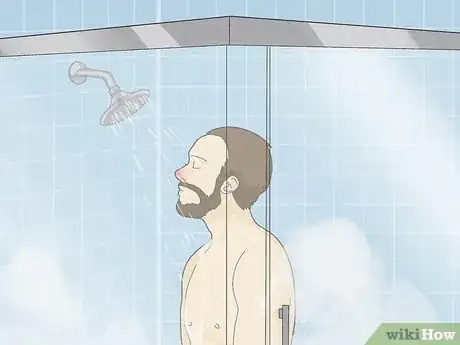
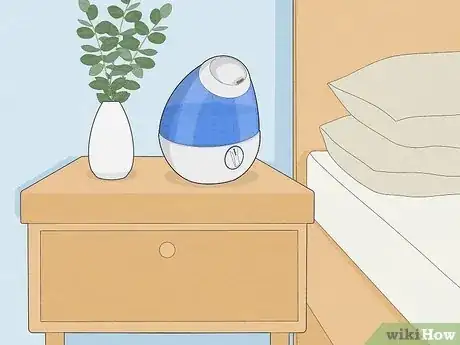

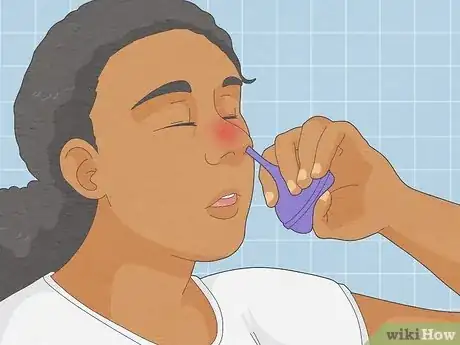
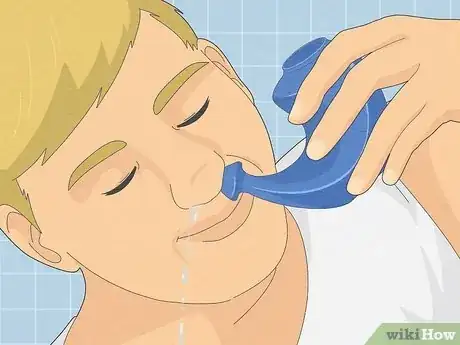


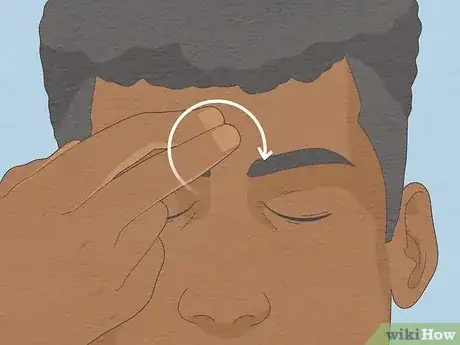
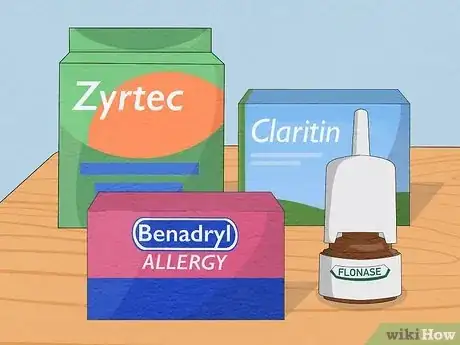

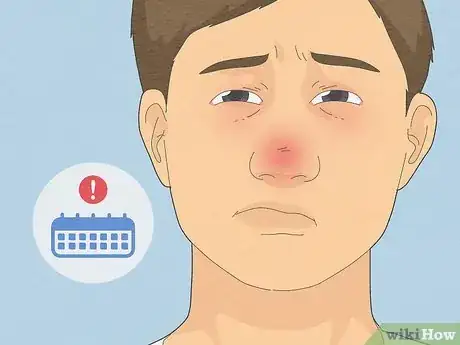

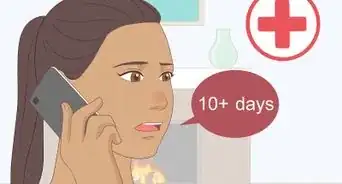
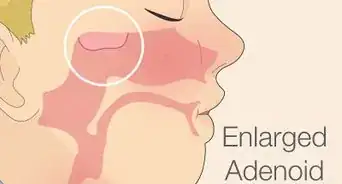


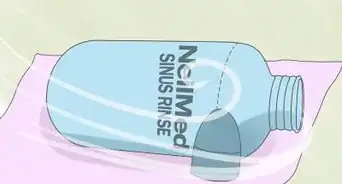
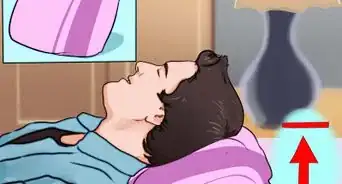
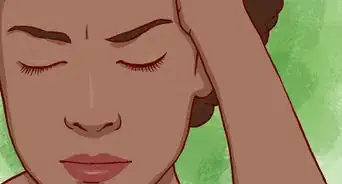



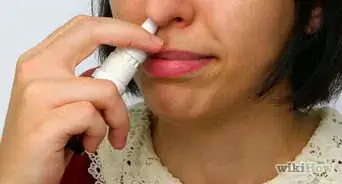
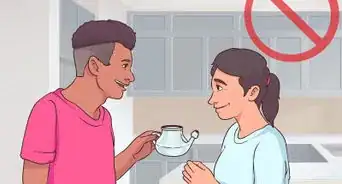










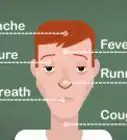


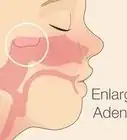



































Medical Disclaimer
The content of this article is not intended to be a substitute for professional medical advice, examination, diagnosis, or treatment. You should always contact your doctor or other qualified healthcare professional before starting, changing, or stopping any kind of health treatment.
Read More...